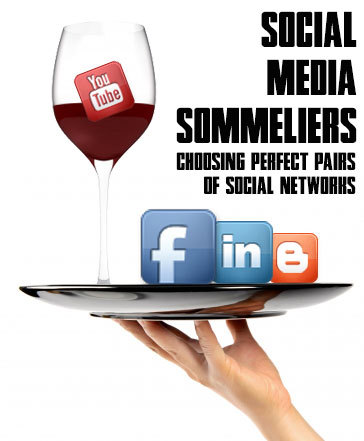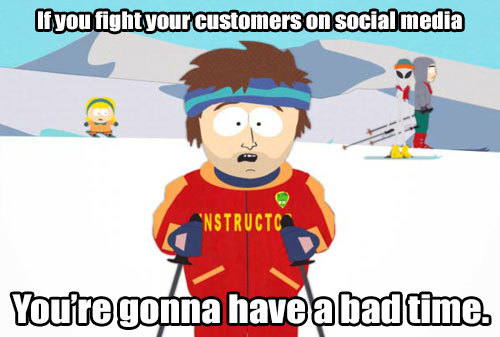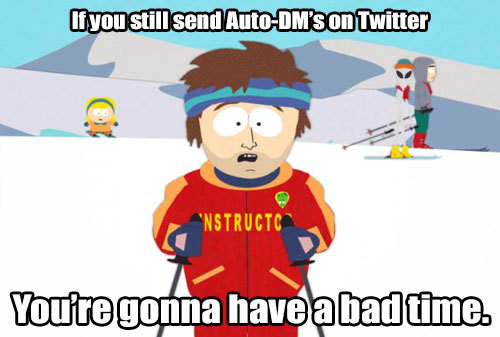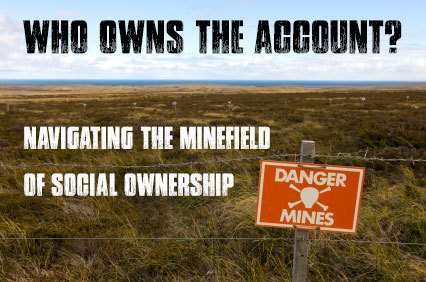
by Jonathan Barrick
A well maintained social media presence is like a fine wine; it develops more character as it ages. As you invest more time in to social media, joining additional networks and using new tools, your presence gains different characteristics that it did not have before. However, just as certain wine characteristics mesh well together, others simply do not. Certain wines will pair well with certain foods and enhance the experience, while others conflict and compete. So it is with different social networks. Some are natural fits, enhancing each other and creating synergy. Others are so vastly different in scope and purpose that using them together can actually weaken the total effort.
So how do you know which networks jive well together, and which just don’t? Well, I reached out to several brilliant professionals whose experiences in social media give them a unique perspective on which networks work great together. They are, for all intents and purposes, Social Media Sommeliers, pairing different networks together to create an experience greater than the sum of its parts. So, what networks do they believe hold the greatest power for synergy?
Here’s what Ric Dragon http://twitter.com/ricdragon had to say:
 “I’m of the mind that the Twitter/G+ combo is killer. G+ is more open than FB, and it’s easier to share blog-type posts publicly. Twitter, of course, is the place for garnering those weak-link connections – those people with whom you share an affinity. So Twitter makes the connection, and G+ allows you to share deeper content with those new connections.”
“I’m of the mind that the Twitter/G+ combo is killer. G+ is more open than FB, and it’s easier to share blog-type posts publicly. Twitter, of course, is the place for garnering those weak-link connections – those people with whom you share an affinity. So Twitter makes the connection, and G+ allows you to share deeper content with those new connections.”
Smart stuff, to be sure. And after speaking with multiple other professionals, and with so many different networks out there to choose from, it became quite clear that everyone would have a different approach tailored to their individual style, fitting with their unique approach to their industry.
I asked this extremely savvy group of Marketing/PR/Social pros to look at this concept from two different angles:
1) Which two social networks do you feel are most complementary, and why?
2) Which two social networks do you feel have the biggest disconnect, and why?
Here’s what they had to say:
Mark Schaefer – http://twitter.com/markwschaefer
 “The biggest synergy that I see is between Blogging and Twitter. Building a Twitter audience is an effective way to build an audience for your blog. A tweet is like the movie trailer for the movie! They fit like a hand in a glove.
“The biggest synergy that I see is between Blogging and Twitter. Building a Twitter audience is an effective way to build an audience for your blog. A tweet is like the movie trailer for the movie! They fit like a hand in a glove.
As I see it, the biggest disconnect in social networks right now is between Google + and everything else. Google is not making the sharing easy so it is probably the least integrated network.”
Peg Fitzpatrick – http://twitter.com/pegfitzpatrick
 “I feel that Google+ and Pinterest are a powerful combination. They are both very visual networks with savvy users. Photographers are really killing it on both platforms such as Trey Ratcliff, with 4.5 million Google+ followers and 4.7 million followers on Pinterest, that’s an enviable social media network! Google+ and Pinterest, more than other platforms, really reward their power users with engagement and activity with their content. You can save your Google+ posts on Pinterest boards or find interesting things to post on Google+ from Pinterest. Both platforms support hashtag usage and using keywords is a benefit. Google+ and Pinterest complement each other and add mutual value without distracting or overwhelming the other.
“I feel that Google+ and Pinterest are a powerful combination. They are both very visual networks with savvy users. Photographers are really killing it on both platforms such as Trey Ratcliff, with 4.5 million Google+ followers and 4.7 million followers on Pinterest, that’s an enviable social media network! Google+ and Pinterest, more than other platforms, really reward their power users with engagement and activity with their content. You can save your Google+ posts on Pinterest boards or find interesting things to post on Google+ from Pinterest. Both platforms support hashtag usage and using keywords is a benefit. Google+ and Pinterest complement each other and add mutual value without distracting or overwhelming the other.
I feel like LinkedIn and every other network are disconnected. LinkedIn doesn’t seem to fit naturally with any of the other networks although they have taken strides towards improvement. The endorsement feature made LinkedIn spammy to me and weakened the recommendations, which I felt was their most valuable asset. I feel that LinkedIn has its place for job seekers and networking but I don’t see how it blends with Pinterest, Facebook or any other site. I think that this was their intention but they shot themselves in the foot with that plan. You need to have a presence on more than one social media platform so if you are on multiple platforms, you’d like to work them seamlessly together.”
Don Power – http://twitter.com/donpower
 “LinkedIn and Twitter work beautifully together for me. I use LinkedIn to get comprehensive background info and details about individuals and their histories and companies before connecting with them on Twitter. Or, you may be connected with a person at Company X on Twitter – you can use LinkedIn to find more people at Company X to connect with (including their Twitter backgrounds). I use them in tandem quite a bit but for me – all roads ultimately lead to Twitter – if I make a connection on LinkedIn, I’m always suggesting that we continue the conversation on Twitter.
“LinkedIn and Twitter work beautifully together for me. I use LinkedIn to get comprehensive background info and details about individuals and their histories and companies before connecting with them on Twitter. Or, you may be connected with a person at Company X on Twitter – you can use LinkedIn to find more people at Company X to connect with (including their Twitter backgrounds). I use them in tandem quite a bit but for me – all roads ultimately lead to Twitter – if I make a connection on LinkedIn, I’m always suggesting that we continue the conversation on Twitter.
Facebook and Twitter – two almost completely exclusive sets of users (in my opinion and personal experience). For example, almost all of my high school friends are on Facebook (I graduated high school in ‘86) but NONE of them are on Twitter. Most of the people I’m connected with on Facebook are not active on Twitter. I only use Facebook to respond to people who find me or reach out to me there. I don’t start conversations on Facebook and 99.9% of my posts on Facebook (unless I’m responding to a specific tagged post) are simply copies of what I post to Twitter (and no – I don’t care that my Facebook posts are often marked up with @ symbols and hashtags)
As I see it, albeit an oversimplification, Facebook is made up of 90% of the people who want to be social 90% of the time. Twitter is made up of 90% of social people who want to do social business communication (in a no sales-y way) 90% of the time. Facebook is 90% wasting time and sharing crap, Twitter is 90% time connecting with people and building networks where the underlying assumption is – how might I be able to leverage this connection, now or in the future, for a business purpose? Because those networks have two completely different modus operandi, they are a total disconnect for me.”
Susie Parker – http://twitter.com/susie_parker
 “I often see how well Facebook and YouTube can work well together. Facebook being the largest social network and YouTube being the second largest search engine makes it easy to share a powerful, compelling, funny, or moving video with a large network of people with one click.
“I often see how well Facebook and YouTube can work well together. Facebook being the largest social network and YouTube being the second largest search engine makes it easy to share a powerful, compelling, funny, or moving video with a large network of people with one click.
There is so much potential with Foursquare and Twitter. But there is too much disconnect and not enough businesses have claimed their locations to maximize the benefit to their businesses. When sharing where you are on Foursquare it would be great to have better Twitter integration to connect better with a potential new place to experience.”
David Christopher – http://twitter.com/davidchris
 “Twitter I find great as a tool to build new relationships and to start conversations that continue on other platforms. It also allows you to connect with your network and keep those important relationships alive in just 140 characters when in today’s busy business world you don’t have time for much more.
“Twitter I find great as a tool to build new relationships and to start conversations that continue on other platforms. It also allows you to connect with your network and keep those important relationships alive in just 140 characters when in today’s busy business world you don’t have time for much more.
Google+ for is the opposite. It’s where conversations continue and evolve (especially with the recent release of Google+ Communities) and for those where the need for much deeper level relationships are important. What I find interesting is that of the Twitter users in my network, very few of them use Google+. For this reason I find they complement each other as they don’t compete against each other for market share.
As for networks that have major disconnects, I’m going to give you a response that maybe you weren’t expecting here. External Social Networks and Enterprise Social Networks. There is a big disconnect between the Enterprise Social Network (behind the firewall) and the External Social Network (beyond the firewall). This isn’t a technology response, but a cultural response. Employees are your companies Brand ambassadors and should be leveraged as such but fear of what they might say prevents this. This is creating a disconnect in consistent messaging and preventing engagement opportunities with your customers.”
Sam Fiorella – http://twitter.com/samfiorella
 “Google+ and YouTube are natural partners and work together for the brand’s benefit on many levels. Google+ Hangouts upload directly to a YouTube channel for one-click cross-network sharing. Further, with Google Authorship, the combo packs a great SEO/SEM punch. There’s little-to-no expertise required to create conversational videos with customers, vendors, the media or others and best of all, the platforms are free!
“Google+ and YouTube are natural partners and work together for the brand’s benefit on many levels. Google+ Hangouts upload directly to a YouTube channel for one-click cross-network sharing. Further, with Google Authorship, the combo packs a great SEO/SEM punch. There’s little-to-no expertise required to create conversational videos with customers, vendors, the media or others and best of all, the platforms are free!
When talking about disconnected networks, I believe those are Pinterest and YouTube. Each are successful in their own right and each is a visual medium. Pinterest is great at sharing with Facebook but doesn’t accept other forms of visual content from other networks well. I see great opportunities for individuals and business if Pinterest would allow the inclusion of videos onto their boards, it would make for a richer experience.”
As for me? I believe that Facebook and Instagram are a very powerful combination. The ease with which you can insert creative, timely images in to your Facebook timeline, and the ease with which users can interact, share, and comment on this activity make them a natural fit for both personal use and for showcasing the personality of a brand.
Where I fail to see much synergy is between Pinterest and Twitter. Much in the same way that the absence of Instagram image support within Twitter has hurt the synergy between them, I feel that it is a crucial missing element that Pinterest should be working towards achieving. Being able to see a pin from within Twitter without the need to click would add a lot of utility, enabling users to view and re-share Tweeted content from Pinterest in one step instead of multiple steps in two different apps.
As you can clearly see, there is no definitive, all-encompassing answer to the question, which appears to be the general nature of social media to begin with. Everyone does it differently, and that’s ok. Ultimately it comes down to your personal ‘taste’ when choosing the social networks that work best for you.
What do you think? Are there two networks that consistently create business magic for you? Or are there two that don’t jive for you at all? Let’s hear!
Jonathan on Google+






 “I’m of the mind that the Twitter/G+ combo is killer. G+ is more open than FB, and it’s easier to share blog-type posts publicly. Twitter, of course, is the place for garnering those weak-link connections – those people with whom you share an affinity. So Twitter makes the connection, and G+ allows you to share deeper content with those new connections.”
“I’m of the mind that the Twitter/G+ combo is killer. G+ is more open than FB, and it’s easier to share blog-type posts publicly. Twitter, of course, is the place for garnering those weak-link connections – those people with whom you share an affinity. So Twitter makes the connection, and G+ allows you to share deeper content with those new connections.” “The biggest synergy that I see is between Blogging and Twitter. Building a Twitter audience is an effective way to build an audience for your blog. A tweet is like the movie trailer for the movie! They fit like a hand in a glove.
“The biggest synergy that I see is between Blogging and Twitter. Building a Twitter audience is an effective way to build an audience for your blog. A tweet is like the movie trailer for the movie! They fit like a hand in a glove. “I feel that Google+ and Pinterest are a powerful combination. They are both very visual networks with savvy users. Photographers are really killing it on both platforms such as Trey Ratcliff, with 4.5 million Google+ followers and 4.7 million followers on Pinterest, that’s an enviable social media network! Google+ and Pinterest, more than other platforms, really reward their power users with engagement and activity with their content. You can save your Google+ posts on Pinterest boards or find interesting things to post on Google+ from Pinterest. Both platforms support hashtag usage and using keywords is a benefit. Google+ and Pinterest complement each other and add mutual value without distracting or overwhelming the other.
“I feel that Google+ and Pinterest are a powerful combination. They are both very visual networks with savvy users. Photographers are really killing it on both platforms such as Trey Ratcliff, with 4.5 million Google+ followers and 4.7 million followers on Pinterest, that’s an enviable social media network! Google+ and Pinterest, more than other platforms, really reward their power users with engagement and activity with their content. You can save your Google+ posts on Pinterest boards or find interesting things to post on Google+ from Pinterest. Both platforms support hashtag usage and using keywords is a benefit. Google+ and Pinterest complement each other and add mutual value without distracting or overwhelming the other. “LinkedIn and Twitter work beautifully together for me. I use LinkedIn to get comprehensive background info and details about individuals and their histories and companies before connecting with them on Twitter. Or, you may be connected with a person at Company X on Twitter – you can use LinkedIn to find more people at Company X to connect with (including their Twitter backgrounds). I use them in tandem quite a bit but for me – all roads ultimately lead to Twitter – if I make a connection on LinkedIn, I’m always suggesting that we continue the conversation on Twitter.
“LinkedIn and Twitter work beautifully together for me. I use LinkedIn to get comprehensive background info and details about individuals and their histories and companies before connecting with them on Twitter. Or, you may be connected with a person at Company X on Twitter – you can use LinkedIn to find more people at Company X to connect with (including their Twitter backgrounds). I use them in tandem quite a bit but for me – all roads ultimately lead to Twitter – if I make a connection on LinkedIn, I’m always suggesting that we continue the conversation on Twitter. “I often see how well Facebook and YouTube can work well together. Facebook being the largest social network and YouTube being the second largest search engine makes it easy to share a powerful, compelling, funny, or moving video with a large network of people with one click.
“I often see how well Facebook and YouTube can work well together. Facebook being the largest social network and YouTube being the second largest search engine makes it easy to share a powerful, compelling, funny, or moving video with a large network of people with one click. “Twitter I find great as a tool to build new relationships and to start conversations that continue on other platforms. It also allows you to connect with your network and keep those important relationships alive in just 140 characters when in today’s busy business world you don’t have time for much more.
“Twitter I find great as a tool to build new relationships and to start conversations that continue on other platforms. It also allows you to connect with your network and keep those important relationships alive in just 140 characters when in today’s busy business world you don’t have time for much more. “Google+ and YouTube are natural partners and work together for the brand’s benefit on many levels. Google+ Hangouts upload directly to a YouTube channel for one-click cross-network sharing. Further, with Google Authorship, the combo packs a great SEO/SEM punch. There’s little-to-no expertise required to create conversational videos with customers, vendors, the media or others and best of all, the platforms are free!
“Google+ and YouTube are natural partners and work together for the brand’s benefit on many levels. Google+ Hangouts upload directly to a YouTube channel for one-click cross-network sharing. Further, with Google Authorship, the combo packs a great SEO/SEM punch. There’s little-to-no expertise required to create conversational videos with customers, vendors, the media or others and best of all, the platforms are free!













